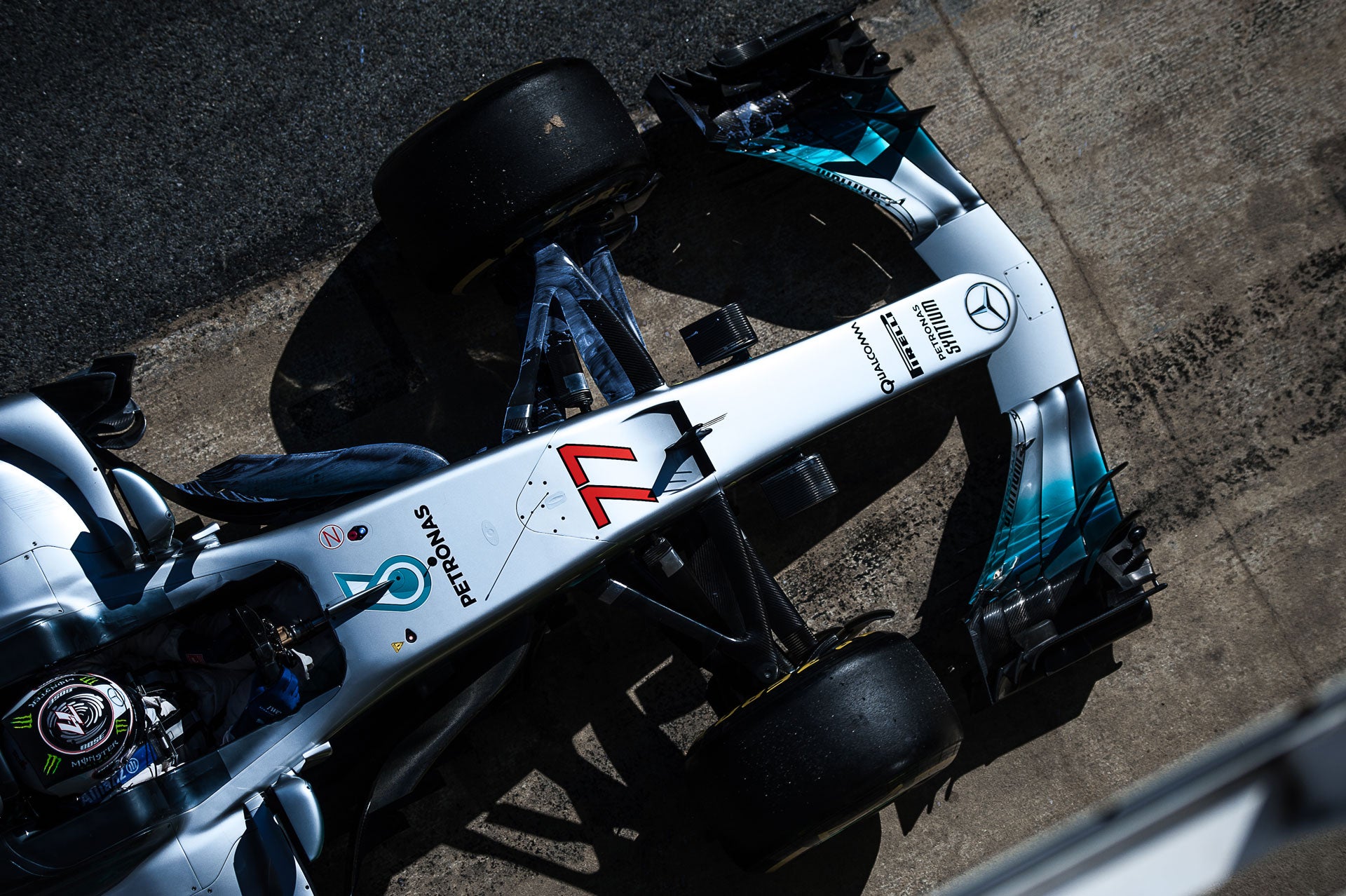
Half a second is a long time in Formula 1. Engineers work painstakingly to make incremental improvements to their car’s performance, using every tool at their disposal. One of those tools is data analytics, which the Mercedes F1 team has used with devastating effect, securing the driver and team title in Brazil earlier this month for the fifth year in a row.
At the core of the Mercedes AMG Petronas data strategy is its flash-array data centres, provided by Pure Storage, a US data storage company.
During a race weekend, each car carries approximately 200 sensors that capture around 100 events per second.
They monitor every aspect of performance and relay that data back to the Mercedes pit area via radar masts spread around the track.
All of this data allows the Mercedes F1 team devise and alter their strategy in real-time: when to pit stop; what to do during an incident; whether to change tyres and so on.
“Those are the things that make and break races,” says Alex McMullan, international CTO of Pure Storage.
How well do you really know your competitors?
Access the most comprehensive Company Profiles on the market, powered by GlobalData. Save hours of research. Gain competitive edge.

Thank you!
Your download email will arrive shortly
Not ready to buy yet? Download a free sample
We are confident about the unique quality of our Company Profiles. However, we want you to make the most beneficial decision for your business, so we offer a free sample that you can download by submitting the below form
By GlobalData“That instant availability of the data is one of the things that makes it so successful for Mercedes.”
“Nothing that’s left unchecked in the sport at all”
The meticulous attention to detail, from monitoring the tyres with infrared sensors to analysing engine health, can also nip a potentially costly incident in the bud.
“Lewis actually had a problem [at the recent Brazil grand prix] with the temperature on his exhaust, which nearly had them retire the car,” explains McMullan.
“But they managed to work around it by turning down the engine effectively.”
Every piece of data collected on race day is held by Pure Storage, which effectively gives the Mercedes F1 team a mobile data centre capability. GPS, weather, car telemetry, photos, videos, DNS service, internet connections – all of these forms of data are amalgamated into one single system.
Even sound is crucial, says McMullan: “They can actually predict the engine revs and how close an engine is to threshold by the acoustics that comes with it.
“There’s nothing that’s left unchecked in the sport at all.”
Mercedes F1’s data-driven design process
Mercedes uses Pure during all stages of the car’s journey, not just on the track.
The design process, for example, is primarily carried out with computational fluid dynamics (CFD), a mathematical simulation. McMullan explains that this allows the engineers “to work on their part of the car in the specific but then also, to fold that into the bigger design”.
This can be applied to all areas of the car, from the front wing to the side pods.
McMullan says that the main advantage of CFD is that it offers a much cheaper and efficient alternative to wind tunnels, which are limited by the Federation Internationale de l’Automobile (FIA) to using a model that’s just 60% of the full size.
“That gives you some sense of things but it’s not perfect,” says McMullan.
“CFD also generates high-resolution movies of air flow, which is how the engineers can visualise what their design’s actually doing to the air flow; how turbulent it is; how disruptive it is as it passes through different stages of the car itself.”
Finite element analysis
The recent crashes by Marcus Ericsson and Fernando Alonso are two examples of high-speed, multiple flips at speeds of over 300kph where the “driver gets out, dusts themselves off and walks off”.
And the reason drivers can often remain relatively unscathed is because of the way data is used to simulate what will happen to different parts of the car in the event of a crash, in what’s known as finite element analysis, or FEA.
This involves physically crash-testing four chassis to “demonstrate that the driver can survive all of the unplanned departures that you see every weekend”.
Even when an F1 car is off the tracks it’s always in motion. Engineers move parts around in the vehicle, which redistributes weight. To do this quickly, they use simulations.
Simulation: “It’s somewhat beyond PlayStation”
McMullan says that the exact nature of the F1 teams’ simulations are “closely held” because it’s such a “huge part of the team’s competitive dynamic”.
It involves companies driving around each race track, mapping it out with lasers, LIDAR and radar to get a “full 3D photo-realistic simulation of each race track.”
“That generates a huge amount of data and that gets fed into the simulator, coupled to the models of download,” says McMullan. “And then the drivers and the test drivers can actually drive the car in a very realistic simulation that includes vibration, including tilt, breaking, acceleration, so they get a full, immersive experience.
“It’s pretty impressive. It’s somewhat beyond PlayStation.”
Too much data
However, there can be too much data – at least in the eyes of the FIA, who limit it for “cost containment reasons”. This limits the amount of data sent back to the teams to just half a terabyte, despite the fact that just one of Pure Storage’s arrays has the capability to support just over 12,000 race cars going around the track.
This cap is in place to prevent the engineers from being overwhelmed by a “massive tsunami of data”.
The FIA has also banned GPUs as part of the cost containment policy, which would better facilitate the use of AI in the data analytics process. This ban is under review, though, and Mercedes and other teams are looking into machine learning.
“They’re still in the development stages with that, but it’s going to be a longer journey because of the GPU restrictions,” says McMullan.
McMullan believes if the ban were lifted it would “change the sport hugely”.
Purists believe it unnecessary and will add more costs.
“Digital entrepreneurs” say that it would help them do their job more quickly and safely.
Five years of winning
Pure Storage began its partnership with Mercedes F1 five years ago, initially just for trackside operations. At just a few inches high, Pure’s storage solution is so much lighter than previous models, which had to be moved by forklift trucks, that the product effectively paid for itself in air freight savings.
During the two companies’ time together, Mercedes has a 100% win record. But can Pure Storage claim any credit for that success?
“I would love to say that we were vital or pivotal,” says McMullan. “I think that we have certainly made their engineer’s jobs a lot easier and we’ve changed the way that they process data both at the track and the factory.
“And we’ve given their onsite team at Brackley a much better experience when the races are live. I would like to claim we’ve taken half a second off the car every year, but ultimately, we’ve just simply – as we’ve done with every business – we’ve enabled the innovators.
“We help them use their tools and datasets a lot more quickly.”







